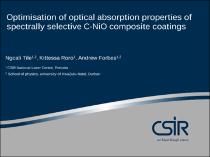 ResearchSpace
ResearchSpace
Optimisation of optical absorption properties of spectrally selective C-NiO composite coatings
JavaScript is disabled for your browser. Some features of this site may not work without it.
- ResearchSpace
- →
- Research Publications/Outputs
- →
- Conference Publications
- →
- View Item
| dc.contributor.author |
Tile, N

|
|
| dc.contributor.author |
Roro, Kittessa T

|
|
| dc.contributor.author |
Forbes, A

|
|
| dc.date.accessioned | 2011-10-17T11:13:44Z | |
| dc.date.available | 2011-10-17T11:13:44Z | |
| dc.date.issued | 2011-05 | |
| dc.identifier.citation | Tile, N, Roro, K.T. and Forbes, A. 2011. Optimisation of optical absorption properties of spectrally selective C-NiO composite coatings. 11th International Conference on frantiers of Polymers and Advanced Materials, University of Pretoria, 22-27 May 2011 | en_US |
| dc.identifier.uri | http://hdl.handle.net/10204/5247 | |
| dc.description | 11th International Conference on frantiers of Polymers and Advanced Materials, University of Pretoria, 22-27 May 2011 | en_US |
| dc.description.abstract | The demand for low cost, efficient and environmental friendly energy is increasing rapidly. Solar thermal energy is being widely investigated as a solution. Efficient thermal solar collectors require a spectrally selective material capable of absorbing as much as possible the solar radiation while re-emitting very little in the infrared range, i.e spectrally selective solar absorbers. The manufacturing process for most of the materials used as selective solar absorbers is complicated and expensive. Carbon in Nickel Oxide (C-NiO) composite material has been found to have a very good spectral selectivity1,2. Moreover this material has a potential of low cost large scale fabrication since it can be fabricated by a simple sol-gel technique. In order to make a step from lab to large scale fabrication it is important to first optimise the properties of the material in an easy to control manner. C-NiO coatings were coated on aluminium substrate using a combination of sol-gel and spin coating technique. Different fabrication parameters were varied in order to optimise these C-NiO coatings for absorptance. Optical properties, surface morphology and chemical analysis were performed on these coatings by use of UV/Vis spectroscopy, Scanning Electron Microscopy (SEM), and Energy dispersive Spectroscopy (EDS), respectively. Solar absorptance values of up to 0.85 accompanied by thermal emittance values of as low as 0.08 were realised on these coatings. | en_US |
| dc.language.iso | en | en_US |
| dc.relation.ispartofseries | Workflow request;7380 | |
| dc.subject | Solar thermal energy | en_US |
| dc.subject | C-NiO | en_US |
| dc.subject | C-NiO coatings | en_US |
| dc.subject | Alternative energy | en_US |
| dc.subject | Polymers | en_US |
| dc.subject | Advanced materials | en_US |
| dc.subject | C-NiO composite coatings | en_US |
| dc.title | Optimisation of optical absorption properties of spectrally selective C-NiO composite coatings | en_US |
| dc.type | Conference Presentation | en_US |
| dc.identifier.apacitation | Tile, N., Roro, K. T., & Forbes, A. (2011). Optimisation of optical absorption properties of spectrally selective C-NiO composite coatings. http://hdl.handle.net/10204/5247 | en_ZA |
| dc.identifier.chicagocitation | Tile, N, Kittessa T Roro, and A Forbes. "Optimisation of optical absorption properties of spectrally selective C-NiO composite coatings." (2011): http://hdl.handle.net/10204/5247 | en_ZA |
| dc.identifier.vancouvercitation | Tile N, Roro KT, Forbes A, Optimisation of optical absorption properties of spectrally selective C-NiO composite coatings; 2011. http://hdl.handle.net/10204/5247 . | en_ZA |
| dc.identifier.ris | TY - Conference Presentation AU - Tile, N AU - Roro, Kittessa T AU - Forbes, A AB - The demand for low cost, efficient and environmental friendly energy is increasing rapidly. Solar thermal energy is being widely investigated as a solution. Efficient thermal solar collectors require a spectrally selective material capable of absorbing as much as possible the solar radiation while re-emitting very little in the infrared range, i.e spectrally selective solar absorbers. The manufacturing process for most of the materials used as selective solar absorbers is complicated and expensive. Carbon in Nickel Oxide (C-NiO) composite material has been found to have a very good spectral selectivity1,2. Moreover this material has a potential of low cost large scale fabrication since it can be fabricated by a simple sol-gel technique. In order to make a step from lab to large scale fabrication it is important to first optimise the properties of the material in an easy to control manner. C-NiO coatings were coated on aluminium substrate using a combination of sol-gel and spin coating technique. Different fabrication parameters were varied in order to optimise these C-NiO coatings for absorptance. Optical properties, surface morphology and chemical analysis were performed on these coatings by use of UV/Vis spectroscopy, Scanning Electron Microscopy (SEM), and Energy dispersive Spectroscopy (EDS), respectively. Solar absorptance values of up to 0.85 accompanied by thermal emittance values of as low as 0.08 were realised on these coatings. DA - 2011-05 DB - ResearchSpace DP - CSIR KW - Solar thermal energy KW - C-NiO KW - C-NiO coatings KW - Alternative energy KW - Polymers KW - Advanced materials KW - C-NiO composite coatings LK - https://researchspace.csir.co.za PY - 2011 T1 - Optimisation of optical absorption properties of spectrally selective C-NiO composite coatings TI - Optimisation of optical absorption properties of spectrally selective C-NiO composite coatings UR - http://hdl.handle.net/10204/5247 ER - | en_ZA |





